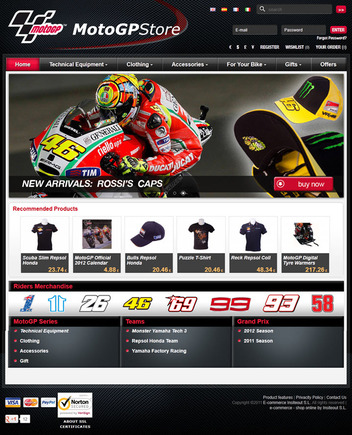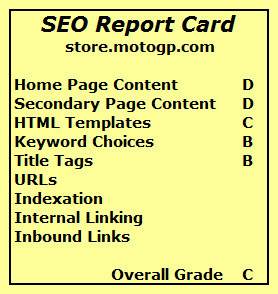Every now and then an ecommerce site raises its hand for an “SEO Report Card.” It’s a great way for the site to get some free advice and a good link, and an interesting way to give Practical eCommerce some, well, practical tips on how we’d handle SEO challenges with real ecommerce sites. Today’s volunteer is the MotoGP Store, the online merchandising arm of the official site for Grand Prix motorcycle racing. The store serves four countries and sells MotoGP branded gear as well as fan gear for popular racers and teams.
Home Page Content
Like many ecommerce sites, MotoGP’s home page is jam-packed with images, branding, and featured content at the expense of actual HTML text on the page.
The MotoGP Store home page as customers see it. Enlarge This Image
Enlarge This Image
When the images are disabled, the remaining text is entirely comprised of navigational links and alternative attributes for images. Neither can hold a candle to an actual piece of permanent body copy for anchoring a keyword theme and enabling a page to rank consistently. Even a short bit of text with 2 to 3 sentences focused on the primary keywords for the page will do the trick. The H1 heading for the home page is “MotoGP Official Store,” placed on the page using CSS image replacement to include both the logo and the HTML text on the page. This practice is above board as long as the words used mirror the words in the image.
The MotoGP Store home page as search engine crawlers index it. Enlarge This Image
Enlarge This Image
Secondary Page Content
The store uses rollover navigation to link customers directly into subcategories of content like “T-shirts” under “Clothing.” This is great for search engine optimization as well as usability because it places a link on every page to each subcategory. Unfortunately, MotoGP Store didn’t create category landing pages such as “Clothing.” Judging by the keyword research, this is a big missed opportunity to rank for some of the store’s larger keywords like “motogp clothing,” “moto gp clothing,” and “motogp apparel.” While they represent a combined 390 Google searches a month globally, in this niche market 390 searches are highly desirable.
Interestingly, by virtue of the breadcrumbs there is a landing page for the category pages. However, they’re only available by navigating to a product in that category and then clicking on the breadcrumb link for the category page. And once the category page has been reached, it’s actually a mirror image of the first subcategory in the navigation rather than a true category page that represents and links to all of the subcategories. For example, to get to the Clothing landing page the user would have to navigate from the home page to a subcategory like T-shirts, and from there to a product page like the “MotoGP Crowd T-shirt,” and lastly click on the “Clothing” link in the breadcrumb. This Clothing category page has a URL of http://store.motogp.com/en/motorcycle-clothing-5, but is identical in every other way to the T-Shirts subcategory page at http://store.motogp.com/en/motorcycle-clothing-5/t-shirts.
Enabling the platform to generate a unique landing page at the category level and to optimize that landing page for unique keywords is key to ranking for the page that can best convert to sales. This is very nearly a moot point for the MotoGP Store because — despite not having a Clothing landing page — MotoGP ranks number 1 in Google U.K. and Bing for “motogp clothing,” “moto gp clothing,” and “motogp apparel.” Why is this? It is links and strength of domain most likely, since MotoGP is the official store for the official MotoGP site. Even Wikipedia links to Motogp.com as the official source for Grand Prix motorcycle racing and MotoGP.
But back to the conversion point. Searchers will convert better when they land on the page that most closely matches their search. Do potential customers searching for “motogp clothing” want t-shirts? Based on the keyword research, many likely do. But others will want more choices like caps and jackets. If they land on a t-shirts page and don’t see caps or jackets immediately, they may bounce back to Google to find a search result that does give them immediate access to caps and jackets as well as t-shirts.
This is pure speculation in the case of the MotoGP Store. Without access to its analytics I can’t tell whether the number 1 rankings are converting to the high volumes of traffic and sales that would be expected. If not, then perhaps the missing category pages are the issue to tackle. If, however, the MotoGP Store finds itself raking in 40 percent of the search traffic from its number 1 ranking and converting at a high rate, then perhaps this issue isn’t an issue at all for them. It would be, however, for another site without the link authority that the MotoGP Store enjoys.
HTML Templates
The templates and navigation allow good internal linking and passage of link popularity down to the subcategory and product levels as mentioned before. But once in the subcategories, the filtering by team, rider, race, gender and size are handled with in AJAX. Consequently the URL does not change when a filter is chosen even though the content changes. So a potential customer searching Google for a Rossi MotoGP T-Shirt will not be shopping on the MotoGP Store. To resolve this issue, the filtering needs to link to specific URLs that load the filtered content. Without those URLs, the search engines have no single page to send searchers to that is optimized for riders or teams or any other filter. The products exist on the site but aren’t aggregated into a single filtered subcategory page that can be crawled, indexed and send sufficient keyword signals to be served up to searchers.
The MotoGP store subcategory filtering as customers see it (left) and the same filtering as search engine crawlers index it (right) without any HTML links. Enlarge This Image
Enlarge This Image
In addition, like the home page the subcategory pages lack textual content beyond the names of the products. To the extent that products are named generically, they may reinforce the keyword theme. But a permanent bit of text would go much farther toward the goal of anchoring a keyword theme for each page. All you need are two to three sentences with careful attention to adding a few keywords, with the primary focus on readability for customers. In addition, the H1 heading on every page of the site is the same as on the home page because the logo’s CSS image replacement treatment has been used in the template and is therefore included on every page. To resolve this, remove the H1 heading from the logo and create a true heading coded with H1 tags to anchor the keyword theme along with the permanent body copy.
Keyword Choices
When the keyword market is as narrow as the one the MotoGP Store is targeting, knowing your keyword targets and nailing them is critically important. You can’t afford to let the competition win any of the keywords when the largest keyword represents only 590 monthly Google searches globally. The focus for the MotoGP Store isn’t MotoGP or motorcycles, it’s specifically the products it sells. The broader MotoGP and motorcycle Grand Prix keywords need to be targeted by the parent site at Motogp.com.
Keyword targets for the MotoGP Store based on initial keyword research. Enlarge This Image
Enlarge This Image
These keywords need to be mapped to the most closely relevant pages on the site. Each keyword should be used on only one page. Optimizing multiple pages for the same keyword just causes self-competition. Several very similar keywords can be used on the same page to reinforce the same keyword theme, however. For example, our earlier example of motogp clothing,” “moto gp clothing,” and “motogp apparel” are similar enough that they could be used to optimize the same page of content.
Title Tags
Across the site, title tags tend to be fairly unique. There appear to be two formats: subcategory title tags tend to have a double colon before and after the text such as “:: MotoGP Buffs – Neck tube ::,” and product title tags tend not to such as “Cyclone Buff MotoGP Cyrace : Clothing Buff® Neck tube.” Regardless of the formatting, the title tags follow best practices by lead with the unique element for the page. The subcategory page leads with the subcategory name “MotoGP Buffs,” and the product page leads with the specific buff’s name. Some of the title tags could benefit from further optimization according to keyword research, but that’s an ongoing process that never ends.
In “Part 2” of this SEO Report Card, I’ll cover URLs and duplicate content, indexation, internal linking, inbound links and the international angle. So far, the MotoGP Store has earned a grade of C — the scale is A, B, C, D, F, with A being the top grade — based primarily on its lack of textual content, lack of category pages and use of AJAX to filter subcategory content.
SEO Report card for "Part 1." Enlarge This Image
Enlarge This Image
However, I’ve also seen some examples of rankings success despite technically not meeting SEO best practices. In “Part 2” I’ll delve deeper into the link portfolio for MotoGP and its official online store, an area I suspect I’ll find they’re earning extra credit. Stay tuned.




